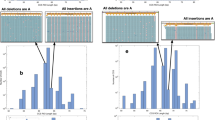Abstract
Several human hereditary neurological and neurodegenerative disease genes are associated with the expansion of CTG repeats. Here we show that the frequency of genetic expansions or deletions in Escherichia coli depends on the direction of replication. Large expansions occur predominantly when the CTGs are in the leading strand template rather than the lagging strand. However, deletions are more prominant when the CTGs are in the opposite orientation. Most deletions generated products of defined size classes. Strand slippage coupled with non–classical DMA structures may account for these observations and relate to expansion–deletion mechanisms in eukaryotic chromosomes for disease genes.
This is a preview of subscription content, access via your institution
Access options
Subscribe to this journal
Receive 12 print issues and online access
$209.00 per year
only $17.42 per issue
Buy this article
- Purchase on Springer Link
- Instant access to full article PDF
Prices may be subject to local taxes which are calculated during checkout
Similar content being viewed by others
References
Brook, J.D. et al. Molecular basis of myotonic dystrophy: expansion of a trinucleotide (CTQ) repeat at the 3′ end of a transcript encoding a protein kinase family member. Cell 68, 799–808 (1992).
Mahadevan, M. et al. Myotonic dystrophy mutation: an unstable CTG repeat in the 3′ untranslated region of the gene. Science 255, 1253–1255 (1992).
La Spada, A.R., Wilson, E.M., Lubahn, D.B., Harding, A.E. & Fischbeck, K.H. Androgen receptor gene mutations in X-linked spinal and bulbar muscular atrophy. Nature 352, 77–79 (1991).
Orr, H.T. et al. Expansion of an unstable trinucleotide CAG repeat in spinocerebellar ataxia type 1. Nature Genet. 4, 221–226 (1993).
The Huntington's Disease Collaborative Research Group. A novel gene containing a trinucleotide repeat that is expanded and unstable on HD chromosomes. Cell 72, 971–983 (1993).
Koide, R. et al. Unstable expansion of CAG repeat in hereditary dentatorubral-pallidoluysian atrophy (DRPLA). Nature Genet. 6, 9–13 (1994).
Nagafuchi, S. et al. Dentatorubral and pallidoluysian atrophy expansion of an unstable CAG trinucleotide on chromosome 12p. Nature Genet. 6, 14–18 (1994).
Wieringa, B. Myotonic dystrophy reviewed: back to the future. Hum. molec. Genet. 3, 1–7 (1994).
Bingham, P.M. et al. Stability of an expanded trinucleotide repeat in the androgen receptor gene in transgenic mice. Nature Genet. 9, 191–196 (1995).
Wells, R.D. Unusual DNA structures. J. biol. Chem. 263, 1095–1098 (1988).
Wells, R.D., Collier, D.A., Hanvey, J.C., Shimizu, M. & Wohlrab, F. The chemistry and biology of unusual DNA structures adopted by oligopurine·oligopyrimidine sequences. FASEB J. 2, 2939–2949 (1988).
Wells, R.D. & Sinden, R.R. Defined ordered sequence DNA, DNA structure, and DNA-directed mutation. Genome Analysis, (eds Davis, K.E. & Warren, ST.) (Cold Spring Harbor Laboratory Press, New York, (1993)7, 107–138.
Wohlrab, F., McLean, M.J. & Wells, R.D. The segment inversion site of herpes simplex virus type 1 adopts a novel DNA structure. J. biol. Chem. 262, 6407–6416 (1987).
Podhajaska, A.J., Hassan, N. & Szybalski, W. Control of cloned gene expression by promoter inversion In vivo:construction of the heat-pulse-activated att-nutL-p-att-N module. Gene 40, 163–168 (1985).
Kang, S., Wohlrab, F. & Wells, R.D. GC-rich flanking tracts decrease the kinetics of intramolecular DNA triplex formation. J. biol. Chem. 267, 19435–19442 (1992).
Trinh, T.Q. & Sinden, R.R. Preferential DNA secondary structure mutagenesis in the lagging strand of replication. in E coli. Nature 352, 544–548 (1991).
Richards, R.I. & Sutherland, G.R. Simple repeat DNA is not replicated simply. Nature Genet. 6, 114–116 (1994).
Eichler, E.E. et al. Length of uninterrupted CGG repeats determines instability in the FMR1 gene. Nature Genet. 8, 88–94 (1994).
Marians, K.J. Prokaryotic DNA replication. A Rev. Btochem. 61, 673–719 (1992).
Kitsberg, D. et al. Allele-specif ic replication timing of imprinted gene regions. Nature 364, 459–463 (1993).
Coverly, D. & Laskey, R.A. Regulation of eukaryotic DNA replication. Ann. rev. Biochem. 63, 745–776 (1994).
Wang, Y.-H., Amirhaeri, S., Kang, S., Wells, R.D. & Griffith, J.D. Preferential nucleosome assembly at DNA triplet repeats from the myotonic dystrophy gene. Science 265, 669–671 (1994).
Fu, Y.-H. et al. An unstable triplet repeat in a gene related to myotonic muscular dystrophy. Science 255, 1256–1258 (1992).
Herrero, M., Lorenzo, V. & Timmis, K.N. Transposon vectors containing non-antibiotic resistance selection markers for cloning and stable chromosomal insertion of foreign genes in gram-negative bacteria. J. Bacteriol. 172, 6557–6567 (1990).
Dower, W.J., Miller, J. & Ragsdale, C.W. High efficiency transformation of E. coli by high voltage electroporation. Nucl. Acids Res. 16, 6127–6145 (1988).
Author information
Authors and Affiliations
Rights and permissions
About this article
Cite this article
Kang, S., Jaworski, A., Ohshima, K. et al. Expansion and deletion of CTG repeats from human disease genes are determined by the direction of replication in E. coli. Nat Genet 10, 213–218 (1995). https://doi.org/10.1038/ng0695-213
Received:
Accepted:
Issue Date:
DOI: https://doi.org/10.1038/ng0695-213
This article is cited by
-
Dynamic alternative DNA structures in biology and disease
Nature Reviews Genetics (2023)
-
RNA biology of disease-associated microsatellite repeat expansions
Acta Neuropathologica Communications (2017)
-
Interrogating the “unsequenceable” genomic trinucleotide repeat disorders by long-read sequencing
Genome Medicine (2017)
-
The role of break-induced replication in large-scale expansions of (CAG)n/(CTG)n repeats
Nature Structural & Molecular Biology (2017)
-
Expansion, mosaicism and interruption: mechanisms of the CAG repeat mutation in spinocerebellar ataxia type 1
Cerebellum & Ataxias (2016)



